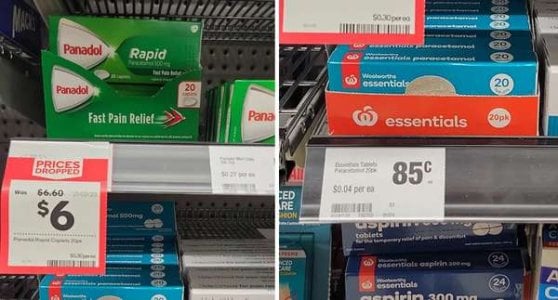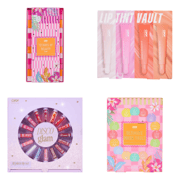Woolies shopper discovers astonishing price difference for a household staple: Are we paying too much?
- Replies 16
As we grow older, we often become more conscious of the money we spend. We scour the aisles for the best deals and look for ways to save on our everyday essentials. But have you ever stopped to think if you're paying too much for some of the most common household items? One Woolworths customer recently discovered a jaw-dropping price difference for a basic medicine that has left many of us scratching our heads and questioning our purchasing habits.
When it comes to medication, do you typically reach for a well-known brand, or are you happy to give generic products a go? If you fall into the former group, you might be paying a staggering 600% more than necessary!
The revelation came when a vigilant shopper spotted a massive price difference between Panadol and Woolworths' own brand of paracetamol. Sharing their discovery on Reddit, the customer revealed that a 20-pack of Panadol Rapid costs $6, while regular Panadol sells for $5.40. Meanwhile, the Woolworths Essentials version – also a 20-pack – is a mere 85 cents!

Breaking it down, that's 30 cents for each Panadol Rapid tablet, 27 cents for regular Panadol, and just 4 cents for a Woolworths Essentials paracetamol pill. This makes the Woolies brand a whopping 606% cheaper than Panadol Rapid and 535% cheaper than regular Panadol.
‘Is there a difference between these two products?’ the Reddit user asked, sparking a heated discussion about consumer expectations and the actual value of medicines at various price points.
As it turns out, Australian regulations require generic drugs to work in the exact same way as their brand-name equivalents. This applies to both prescription and over-the-counter medicines. According to the NPS Medicinewise website, generic medicines must be approved by the Therapeutic Goods Administration (TGA) and meet the same strict standards of quality, safety, and effectiveness as the original brand.
But if they're so similar, why is there such a significant price difference? The answer lies in the costs associated with developing and marketing a new drug. Brand-name manufacturers often invest large sums of money in creating a medicine with a new active ingredient, which is then protected by a patent for several years. Once the patent expires, other pharmaceutical companies can create drugs using the same active ingredient at a fraction of the cost.
In fact, consumer advocacy group CHOICE points out that generic and brand versions of the same drug may even be produced in the same factory by the same manufacturer! The main differences between the two tend to be the inactive ingredients, known as excipients, which can include coatings, fillers, binding agents, and dyes.
If you have certain medical conditions or allergies that prevent you from ingesting or being exposed to these inactive ingredients, you may need to consult your pharmacist or doctor before choosing a medicine brand. However, for most people, generic medicines offer the same benefits as their brand-name counterparts – at a fraction of the price!
According to the Australian Institute of Health & Wellness, in 2020–21, the Australian Government recorded $13.9 billion in spending on all PBS and RPBS medicines, or $541 per person. With such a significant amount of money being spent on medications, it's no wonder that the market share of generic medicines has been increasing in recent years.
In response to the price differences between paracetamol products at Woolworths, a spokesperson for the retailer said, ‘We offer a wide range of products and brands to cater to different customer preferences and budgets.’
So, dear members, don't be swayed by flashy packaging or well-known names next time you're shopping for your household staples. Instead, consider trying generic products – your wallet will thank you! And remember, this principle applies to not just medicines but also cleaning products, pantry staples, and toiletries.

To further assist you in making informed decisions when selecting between brand-name and generic products, here are a few tips on how to read and compare labels on medication packaging:
1. Look for the active ingredient – this should be the same in both brand-name and generic versions.
2. Check the dosage – the amount of active ingredient per tablet or capsule should be consistent between products.
3. Examine the list of inactive ingredients – some individuals may have sensitivities or allergies to certain excipients.
4. Talk to your GP before making the switch - it’s always better to be safe than sorry when it comes to your health.
The history of generic medicines dates back to the 20th century when the expiration of patents for brand-name drugs allowed other manufacturers to produce and sell cheaper alternatives. Over time, government regulations and industry standards have evolved to ensure that generic medications are just as safe and effective as their brand-name counterparts.
By choosing generic products for your household needs, you're saving money and contributing to a more sustainable and cost-effective healthcare system. Happy shopping, and may your savings continue to grow!
When it comes to medication, do you typically reach for a well-known brand, or are you happy to give generic products a go? If you fall into the former group, you might be paying a staggering 600% more than necessary!
The revelation came when a vigilant shopper spotted a massive price difference between Panadol and Woolworths' own brand of paracetamol. Sharing their discovery on Reddit, the customer revealed that a 20-pack of Panadol Rapid costs $6, while regular Panadol sells for $5.40. Meanwhile, the Woolworths Essentials version – also a 20-pack – is a mere 85 cents!

Generic paracetamol is a tiny fraction of the cost of the branded version. Source: Reddit/DOSHman154
Breaking it down, that's 30 cents for each Panadol Rapid tablet, 27 cents for regular Panadol, and just 4 cents for a Woolworths Essentials paracetamol pill. This makes the Woolies brand a whopping 606% cheaper than Panadol Rapid and 535% cheaper than regular Panadol.
‘Is there a difference between these two products?’ the Reddit user asked, sparking a heated discussion about consumer expectations and the actual value of medicines at various price points.
As it turns out, Australian regulations require generic drugs to work in the exact same way as their brand-name equivalents. This applies to both prescription and over-the-counter medicines. According to the NPS Medicinewise website, generic medicines must be approved by the Therapeutic Goods Administration (TGA) and meet the same strict standards of quality, safety, and effectiveness as the original brand.
But if they're so similar, why is there such a significant price difference? The answer lies in the costs associated with developing and marketing a new drug. Brand-name manufacturers often invest large sums of money in creating a medicine with a new active ingredient, which is then protected by a patent for several years. Once the patent expires, other pharmaceutical companies can create drugs using the same active ingredient at a fraction of the cost.
In fact, consumer advocacy group CHOICE points out that generic and brand versions of the same drug may even be produced in the same factory by the same manufacturer! The main differences between the two tend to be the inactive ingredients, known as excipients, which can include coatings, fillers, binding agents, and dyes.
If you have certain medical conditions or allergies that prevent you from ingesting or being exposed to these inactive ingredients, you may need to consult your pharmacist or doctor before choosing a medicine brand. However, for most people, generic medicines offer the same benefits as their brand-name counterparts – at a fraction of the price!
According to the Australian Institute of Health & Wellness, in 2020–21, the Australian Government recorded $13.9 billion in spending on all PBS and RPBS medicines, or $541 per person. With such a significant amount of money being spent on medications, it's no wonder that the market share of generic medicines has been increasing in recent years.
In response to the price differences between paracetamol products at Woolworths, a spokesperson for the retailer said, ‘We offer a wide range of products and brands to cater to different customer preferences and budgets.’
So, dear members, don't be swayed by flashy packaging or well-known names next time you're shopping for your household staples. Instead, consider trying generic products – your wallet will thank you! And remember, this principle applies to not just medicines but also cleaning products, pantry staples, and toiletries.
Key Takeaways
- A shopper spotted a massive price difference between Panadol and store-brand paracetamol sold by Woolworths.
- Australian regulations require generic drugs to work in the exact same way as their brand-name equivalent, including the same potential health benefits and side effects.
- Generic medicines must be approved by the Therapeutic Goods Administration (TGA) and meet the same strict standards of quality, safety, and effectiveness as the original brand.
- The reason for the price gap is that brand-name medicines usually come with a higher price tag than their generic counterparts because the manufacturers of generic drugs don't incur expenses in developing a drug or purchasing the rights to market it.
To further assist you in making informed decisions when selecting between brand-name and generic products, here are a few tips on how to read and compare labels on medication packaging:
1. Look for the active ingredient – this should be the same in both brand-name and generic versions.
2. Check the dosage – the amount of active ingredient per tablet or capsule should be consistent between products.
3. Examine the list of inactive ingredients – some individuals may have sensitivities or allergies to certain excipients.
4. Talk to your GP before making the switch - it’s always better to be safe than sorry when it comes to your health.
The history of generic medicines dates back to the 20th century when the expiration of patents for brand-name drugs allowed other manufacturers to produce and sell cheaper alternatives. Over time, government regulations and industry standards have evolved to ensure that generic medications are just as safe and effective as their brand-name counterparts.
By choosing generic products for your household needs, you're saving money and contributing to a more sustainable and cost-effective healthcare system. Happy shopping, and may your savings continue to grow!







